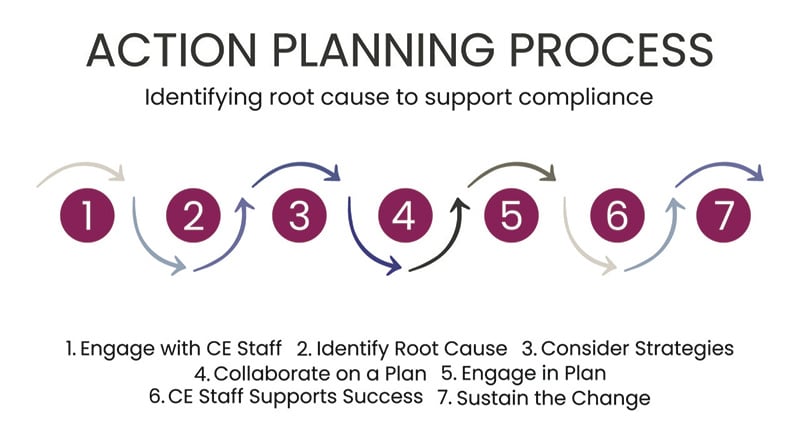New Approach to Supporting Providers’ Compliance: The Year in Review
June 1, 2023
Last March, CE changed its compliance model by eliminating appeals (and appeal fees) and replacing them with a consultative approach. Many of you have seen the workflow [PDF] that illustrates the process, and some of you have engaged in that process. After 1 year, we wanted to provide an update on how things are going, what positives we’ve seen, and the challenges that we continue to address.
When a compliance issue arises, CE staff will initiate the consultative approach to supporting providers. Those of you who are audiologists or speech-language pathologists (SLPs) may recognize this approach, as it resembles the therapeutic model—where you collect background information, make a diagnosis, and set forth short- and long-term goals to facilitate success.

So, how’s it been going? Overall, we’ve heard from both Providers and staff that this is a more human approach that considers the realities of each organization’s personnel, structure, and processes and that does not simply “punish” noncompliance without helping the organization facing this issue. For example, we’ve learned that many reporting issues are related to manual data entry, thus increasing the chance of human error. This has opened conversations about options to reduce manual entry, which has, in part, led to a 33% decrease in inaccurate reporting! This is great news not only for you but also for all of your learners who are receiving ASHA continuing education units (CEUs) in a timely and accurate way.
And what do CE staff and Providers think? Joan Oberlin, ASHA CE Provider Manager, noted that, “Since implementing the new compliance model, I have experienced better, more productive conversations with my CEAs. We work together to uncover their barriers to compliance. And I find and share tools to help them overcome these issues. I can see better performance in many Providers already.” A Provider who has engaged in an action plan with CE said, “Instead of the old appeal process and paying a fine, the action plan resulted in us auditing our current systems and recommending to our IT team an upgrade to the more efficient spreadsheet reporting process. This experience also built a stronger relationship with our ASHA team members. This relationship has proven invaluable as adding the weight of their recommendations to ours allowed us to ensure that our IT department implemented the reporting updates sooner than expected. This implementation has significantly streamlined reporting time for us, and the rosters are posted by ASHA more quickly.”
No new process is without challenges, and the new compliance approach is no exception. There has been a learning curve for both the ASHA CE staff and Providers on how to best engage in conversations that uncover the root cause of compliance issues. And, as with any change, there are varied degrees of buy-in and differing views about the need or desire for partnership. We continue to address these challenges through staff training, improved communications with Providers, and updated resources and guidance.
The bottom line is that we hope those who engage in the process will increasingly see ASHA CE as a partner who supports you and is invested in your success. Because our goal is to get to the root cause of compliance issues, we offer the following resources.
- 5 Whys: The purpose of 5 Whys is to drill down on a particular problem by asking “Why?” until you identify the core problem. The 5 Whys tool is best used when implemented with a Pareto analysis.
- Fishbone diagram: The Fishbone diagram’s purpose is to identify the many possible causes for a problem and to sort ideas into useful categories. The fishbone diagram should be implemented when the root cause is entirely unknown.
- Pareto chart: The Pareto chart’s purpose is to show which factors are more significant for a problem.











